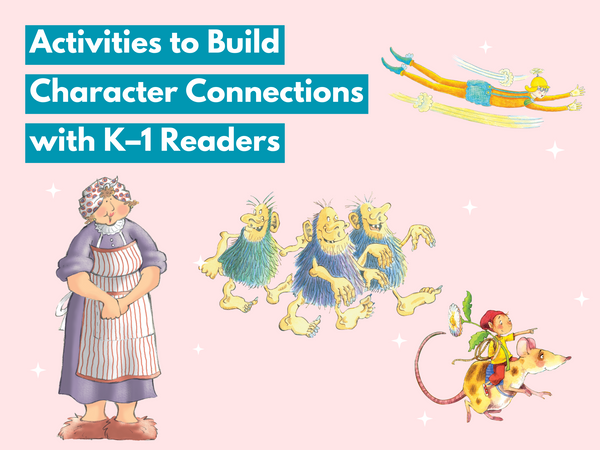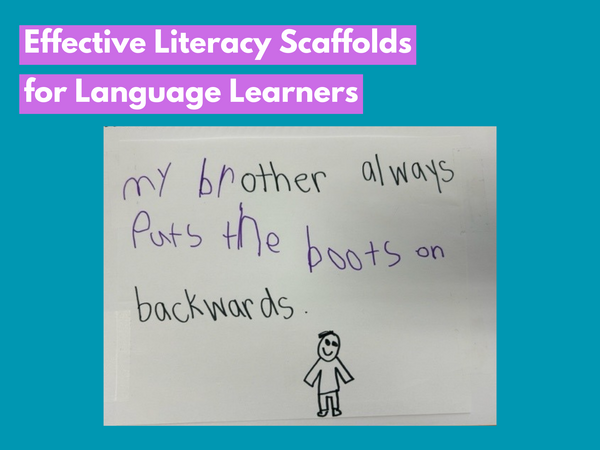By Paula Dugger, M. Ed., Guest Blogger
Marie Clay concluded that readers and writers use common skills and strategies that each contribute to both areas in the development of literacy. Using a balanced literacy framework helps young children simultaneously grow as readers and writers. Keep reading because I'll provide some easy and fun ways for you to help individual students and small groups improve writing skills.
Children have been learning to write from the moment they grabbed a crayon to begin scribbling on a surface. Often, kids lose confidence in writing when they begin formal education because of rules and expectations. Children go through developmental stages of writing according to their age, experience, and exposure to writing. This is why it's important to express to children that their early attempts at writing are valid. Try some of the following ideas to help students with writing in your classroom.
Drawing and Scribbling: One way to help children develop their writing skills is by allowing them to draw pictures or make marks on the page to convey a message. Start by reading a story, such as Little Rabbit's Story , and ask them to draw a picture of their favorite character or part of the story. Invite each child to tell you about their picture, and what they would say in words about the picture. You can record each child’s message by writing their words on the page and then help them read what was dictated.
Writing with a Shared Pen: As you help children build confidence and skills with writing, allow them to share a pen to add known letters in words they recognize. If a child wants to write about a dog and knows the letter D , allow him or her to write that letter on the page and then share the pen with other kids. Over time, you can adjust the amount of letters that students write according to their mastery of letter identification and writing.
 Retelling Narrative Texts in Groups:
You can have a small guided reading group practice retelling a narrative text, such as
My Noisy House
. While reading the story with the group, you can model specific reading skills such as where to start reading on a page, using punctuation to determine inflection, and rereading a sentence for accuracy. Then you can have students practice retelling by drawing pictures that correspond to the main events of
My Noisy House
. Once this is completed, you can encourage kids to take turns rereading their illustrated stories. You can do this with additional fun narrative texts from the
Kaleidoscope Collection
,
Joy Cowley Early Birds
, or the
Joy Cowley Collection
.
Retelling Narrative Texts in Groups:
You can have a small guided reading group practice retelling a narrative text, such as
My Noisy House
. While reading the story with the group, you can model specific reading skills such as where to start reading on a page, using punctuation to determine inflection, and rereading a sentence for accuracy. Then you can have students practice retelling by drawing pictures that correspond to the main events of
My Noisy House
. Once this is completed, you can encourage kids to take turns rereading their illustrated stories. You can do this with additional fun narrative texts from the
Kaleidoscope Collection
,
Joy Cowley Early Birds
, or the
Joy Cowley Collection
.
Using Alphabet Books as a Template: Phonics and phonemic awareness are necessary components of reading and writing because kids need to learn what sounds match the letters they see in print. You can teach these explicitly in a planned mini-lesson or when an opportunity arises during guided reading or writing. A great way to help children with learning letter sounds and writing is by associating letters with particular words in Letter Buddies Starters . You can make sheets with similar sentences seen on each page and provide a space for students to illustrate and make meaning for a sentence like Here is a ball .
 Making Animal Books for Kids:
Helping kids make their own animal alphabet book is another fun activity to use to help improve writing. To make an easy animal book, have each child find the words of animals whose first letter corresponds with the letters of the alphabet. To encourage practice with sight words in sentences, you can encourage students to repeat a simple sentence structure while changing the name of the animal as they move through the alphabet. For example,
I see the anteater. I see the buffalo.
You can use animal books for kids within
Zoozoo Into the Wild
or
Zoozoo Animal World
as anchor texts.
Making Animal Books for Kids:
Helping kids make their own animal alphabet book is another fun activity to use to help improve writing. To make an easy animal book, have each child find the words of animals whose first letter corresponds with the letters of the alphabet. To encourage practice with sight words in sentences, you can encourage students to repeat a simple sentence structure while changing the name of the animal as they move through the alphabet. For example,
I see the anteater. I see the buffalo.
You can use animal books for kids within
Zoozoo Into the Wild
or
Zoozoo Animal World
as anchor texts.
Having Fun with Names: Focusing students' attention on proper nouns, like a child’s name, or common nouns, such as cat or dad , is an easy way to introduce children to how words work. For instance, my grandson’s name is Blake. Although he is only 3 years old, he can verbally spell his name and makes attempts to write his name by copying from a model. With uppercase and lowercase magnetic letters , I have shown him how he can make other words that rhyme with his name to help pave the way for him to develop a list of words he can read and write. By replacing the letters B and L with different consonants, the chunk -ake can be made into new words, such as bake, lake, cake, make, take, etc. You'll see how much fun kids have with activities like this because they are in control of building new words from known words and word parts.
You can easily motivate children to write when they see how much fun they can have with fun and vibrant narrative and informational leveled readers. If you're looking for a professional resource about writing across the curriculum, workshops, assessments and more, you'll want to explore Kid Writing in the 21st Century .
Don't forget to visit our blog soon for more tips to help your students!
 Paula is an educational consultant who has previously served as a Reading Recovery Teacher/Teacher Leader, first grade teacher, Title I and high school reading teacher, and a Reading Coordinator. If you like what you read here, you can enjoy
more from Paula on our blog
.
Paula is an educational consultant who has previously served as a Reading Recovery Teacher/Teacher Leader, first grade teacher, Title I and high school reading teacher, and a Reading Coordinator. If you like what you read here, you can enjoy
more from Paula on our blog
.








